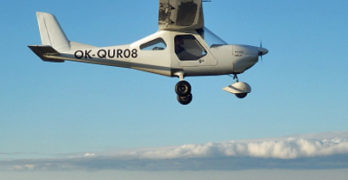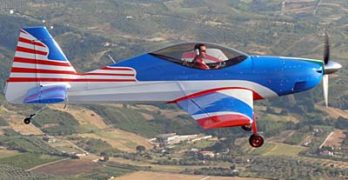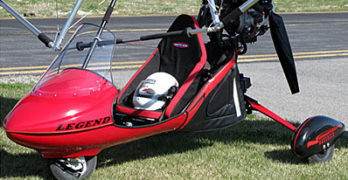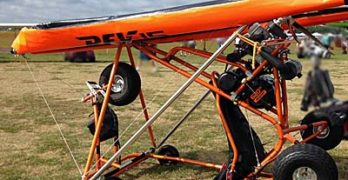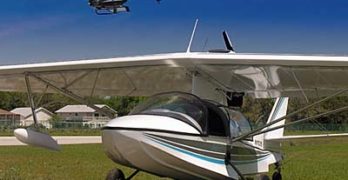The “Big Show” is just days away, so of course, journalists and readers are asking what will be present? The question is worthwhile, but often the most interesting discoveries are not foretold either to maintain secrecy or due to the last minute scramble to make a new project showable. Here are four products attendees may want to investigate. Watch for more previews.
“What a journey so far, wrote Jordan Denitz, spokesman for The Airplane Factory USA! Globetrotters Mike Blyth with Patrick Huang of The Airplane Factory Asia have completed their first three legs on their way around the world in a Sling powered by the Rotax 912iS. Starting in Johannesburg, South Africa, they traveled to Namibia, Ghana, and Cape Verde.
On Monday they were taking a well deserved rest after 37 hours and more than 4,000 nautical miles logged so far. “They are gearing up for the biggest hop yet, crossing the Atlantic,” added Jordan.
Search Results for : Part 103
Not finding exactly what you expected? Try our advanced search option.
Select a manufacturer to go straight to all our content about that manufacturer.
Select an aircraft model to go straight to all our content about that model.
Forty Years of Rotax Aircraft Engines
Aircraft engine giant, Rotax BRP has reached an anniversary: forty years of making powerplants used around the world by airframe makers of ultralights to Very Light Aircraft. Thus, it was hardly a surprise when Light-Sport Aircraft came along eleven years ago that the Austrian company immediately became the largest supplier of engines … capturing an estimated 80% of the market, even while other ASTM-approved engines are in use from Continental, Jabiru, Lycoming, and HKS. New candidates include Superior’s Gemini Diesel and, of course, the ECi Titan 180-horsepower engine has seen good acceptance. Then we have another batch of engines for kit-built aircraft including Viking (based on Honda), UL-Power, AeroVee (VW), AeroMomentum (Subaru), Corvair, and more.
Despite the many other choices, Rotax has retained a dominant position. I’ve long felt that while it can be challenging to bring a new airframe to market and win some customers, it is even harder to introduce a new engine.
PSA: An Affordable Aircraft?
The following article is a guest editorial by Chip Erwin, a name many rightfully associate with the highly successful SportCruiser LSA. A restless entrepreneur, Chip has been working behind the curtain for several years. He emerged with the Zigolo and is now proposing a fresh name for a segment that seems to have energy behind it. I have reported on England’s new SSDR 300 category and I have observed the rejuvenation of Part 103 vehicles. So, on our recent travels to China, I encouraged Chip to express what he has in mind.
Article Update 6/15/15 — At the end of this article see our video shot at Sun ‘n Fun 2015 regarding Chip’s electric motor and plans.
Is “affordable aircraft” an oxymoron? For most people, probably yes. One answer could be a class of aircraft I like to refer to as a PSA, or Personal Sport Aircraft.
Is FAA Falling Behind Other National CAAs?
Let’s set the way-back machine to two dates and examine the actions of our good friends at FAA. One date was September 1982. Another date was September 2004.
Date #1 was the time when FAA announced Mike Sacrey and team’s remarkable Part 103. This rule has lasted for 33 years and continues to hold interest (see earlier article on the subject). Date #2 was when FAA announced the SP/LSA rule engineered by Sue Gardner and her team. I continue to applaud their initiative for both simplified rules where they stepped far back and let the market do its magic. Both have increased the freedom of pilots to fly what and how they prefer. Kudos, FAAers!
Part 103 is strictly single seat since the two-seat “103 trainers” were forced into ELSA status. Does a market exist for one-place aircraft? I always cite this survey result from AOPA. After many years of asking, the big member group determined the average occupancy of a GA aircraft was 1.6 persons.
Considering the Emerging Aviation Market in China
To say anticipation is high regarding the development of a China general aviation market might be the understatement of the century. Having earlier observed the auto market grow exponentially — Mercedes reportedly sells more of their luxury cars in China than America — pioneering aviation marketers are brimming with anticipation. Most readers are well aware of the investments made by wealthy Chinese in American aircraft companies.
The country has been on a three-decade-long infrastructure-building binge to exceed any such development in human history and at the Anyang GA Expo (my shortened name for it), we heard highly-placed government officials make speeches about new airport-building plans.
Like many aviators initially contemplating this country — I just completed my first visit — I can sense the boundless enthusiasm. A middle class that might afford light aircraft is said to be larger than the entire U.S. population. Securing even a small sliver of such an untapped potential could foster an entire industry.
Wings from the North Lift Many Trikes
I’ve been writing about very affordable aircraft•, specifically about Part 103 ultralight vehicles. I know some readers prefer speedier or fully enclosed aircraft. Those people are fortunate as many choices are available and, of course, I will continue writing about them frequently. However, many pilots in the USA and around the world do not have a budget for a magnificent carbon fiber personal aircraft that costs $150,000. Even among those who can afford such aircraft, I’m amazed at the renewed interest in these simplest of aircraft.
In addition, aircraft as shown in the nearby photos have seen considerable development since the early days of weight shift trikes. In my view, America invented these aircraft back in the late 1970s but as three axis ultralights developed, interest from American pilots drew away from weight shift and the best new ideas seemed to come from Europe, Australia or other countries. However, I now see the freshest developments coming from U.S.
Is Rev for You? …for Less Than $18,000?
UPDATE 5/10/15 – Rev Videos — Shortly after the following article was written, we posted two videos about Evolution’s new Rev. Part 1 shows you how fast the setup from trailer to flight goes and Part 2 gives more information, both featuring primary developer Larry Mednick. Enjoy! –DJ
Earlier I’ve written that the Part 103 ultralight sector seemed more vibrant than ever at this year’s Sun ‘n Fun. I admit a bias. I love Part 103 … the aircraft, the concept, I like flying single seat aircraft, and, hugely, I love that Part 103 deftly avoids most of the interference from government officials that tends to dominate so much of aviation worldwide. While certified aircraft have hundreds or thousands of pages of regulations they must follow, Part 103’s entire ruleset can be printed on the front and back of a single piece of paper. That’s fantastic!
Earlier a few folks reading my enthusiasm about Sun ‘n Fun 2015 exhibits of Part 103 machines voiced doubt that these machines can actually qualify — meeting the challenging empty weight of 254 pounds (278 if a parachute is mounted; more if floats are added); the max speed of 55 knots or 63 mph; the stall of 24 knots or 28 mph; the five gallons of fuel, and, well … that’s nearly it.
Love Them or Not, Drones Are Coming
The good news is that most pilots I’ve interviewed — with a few outspoken exceptions — think drones are fine. Some are openly enthusiastic. Indeed, major drone seller Atlanta Hobby said their most effective advertising ever was on Barnstormers, an online source frequented by pilots (the sort that fly from inside the aircraft). This article will try to cast additional light on the new drone rule, FAR Part 107, that was announced over last weekend and gained wide coverage.
I contacted a subject matter expert who happens to be a longtime friend. Cliff Whitney is the fellow that first talked me into starting ByDanJohnson.com way back in 1999. Much earlier we met through a mutual interest in hang gliding and have remained friends ever since. Today, Cliff runs a multimillion dollar enterprise that sells … well, things that fly (but with the pilot not inside). He remains an active pilot that enjoys flying several airplane types so he gets it from a pilot’s perspective.
7 Aircraft to Look for at Sebring 2015
We’re off to the races … OK, the race track … OK, we’re off to Sebring, which happens to be alongside the Sebring International Raceway. Yep. It’s January so it’s again time for the Sebring Expo, this time number 11, the 2015 edition of the popular Florida show. I’ll be onsite for the four days, which this year is one day sooner, running Wednesday through Saturday. The plan makes it easier for vendors to stay to the end on Saturday and still have time to get home on Sunday so they can be back in their businesses on Monday.
Every time I head to a show people contact me, including journalists from publications that don’t follow Light-Sport, light kits, ultralights, or light GA as closely as we do). The question is always the same. What new aircraft or products will we see at the show? …Uh, let me think.
Fresh American LSA & Ultralight Exports
Wait! “…Exports?” I realize that might look like a typo. Did I intend to write LSA imports? Nope, exports is the correct word. Back in the early days of Light-Sport Aircraft, circa 2005-6-7, the source countries manufacturing the LSA people were buying were of a high percentage European with the Czech Republic leading the charge. Their penetration of the market was approximately two-thirds of all LSA. Then came the global economic recession, which happened as the industry began to mature. All were affected: domestic and international companies and pilot consumers. Some handsome imported aircraft never found a market.
In any downturn, some managers adapt quicker to the changing economy. They find a way to offer new aircraft to keep the momentum. Neither were American companies sitting on their thumbs. European builders had a head start because the European-style ultralights they had been manufacturing were close to what FAA allowed as LSA, so many models could be rapidly adapted to meet the Yankee marketplace.
- « Previous Page
- 1
- …
- 24
- 25
- 26
- 27
- 28
- …
- 53
- Next Page »




